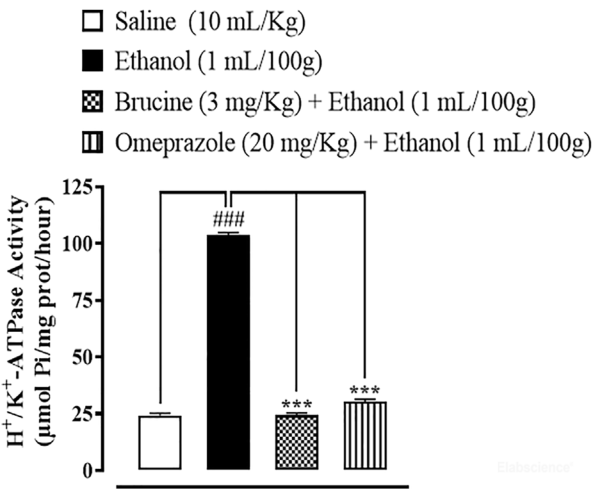
H+K+-ATPase Activity Assay Kit
SKU: E-BC-K122-S-200
H+K+-ATPase Activity Assay Kit
| SKU # | E-BC-K122-S |
| Detection Instrument | Spectrophotometer (660 nm) |
| Detection Method | Colorimetric method |
Product Details
Properties
| Sample Type | Animal tissue, cells |
| Detection Method | Colorimetric method |
| Assay type | Enzyme Activity |
| Assay time | 60 min |
| Precision | Average inter-assay CV: 9.800% | Average intra-assay CV: 4.400% |
| Other instruments required | Micropipettor, Centrifuge, Incubator, Water bath, Vortex mixer |
| Other reagents required | Normal saline (0.9% NaCl) |
| Storage | Reagent 4: -20℃, others: 2-8℃ |
| Valid period | 12 months |
Images
M Noman et al investigate the antioxidant and anti-inflammation capacity of brucine. H+/K+-ATPase activity of rat gastric was determined using H+/K+-ATPase activity assay kit (E-BC-K122-S).

The activity of H+/K+-ATPase was significantly increased by ethanol and reduced in treating groups. (###P<0.001 vs saline group, ***P<0.001 with ethanol group).
Dilution of Sample
Dilute the 10% tissue homogenate to different concentrations of 2%, 1%, and 0.5%, then take 100 μL for pre-experiment according to the operation steps. The OD value of sample tube should be less than 1.0.
The recommended dilution factor for different samples is as follows (for reference only):
| Sample type | Dilution factor |
| 10% Animal tissue homogenate | 5 |
| GES-1 cells (2.52mg/mL) | 1 |
Note: The diluent is normal saline (0.9% NaCl).
Detection Principle
ATPase can decompose ATP to produce ADP and inorganic phosphorus. The activity of ATPase can be expressed by measuring the production amount of inorganic phosphorus in unit time. The inorganic phosphorus reacts with ammonium molybdate in acidic solution to form ammonium molybdate compound, which is reduced with reducing agent to form molybdenum blue, and has absorption peak at 660 nm. Determine the concentration of molybdenum blue to calculate the amount of inorganic phosphorus.
Kit Components & Storage
| Item | Component | Size 1 (100 Assays) |
Size 2 (200 Assays) |
Storage |
| Reagent 1 | Buffer Solution | 20 mL ×1 vial | 40 mL ×1 vial | 2-8°C, 12 months |
| Reagent 2 | Accelerator | 8 mL ×1 vial | 16 mL ×1 vial | 2-8°C, 12 months |
| Reagent 3 | Acid Solution | 8 mL ×1 vial | 16 mL ×1 vial | 2-8°C, 12 months |
| Reagent 4 | Substrate | Powder ×1 vial | Powder ×2 vials | 2-8°C, 12 months |
| Reagent 5 | Inhibitor | Powder ×1 vial | Powder ×2 vials | 2-8°C, 12 months |
| Reagent 6 | Complexing Agent |
6 mL ×1 vial | 12 mL ×1 vial | 2-8°C, 12 months |
| Reagent 7 | Stop Solution | 10 mL ×1 vial | 10 mL ×2 vials | 2-8°C, 12 months |
| Reagent 8 | Reducing Agent | Powder ×2 vials | Powder ×3 vials | 2-8°C, 12 months, shading light |
| Reagent 9 | Chromogenic Agent | Powder ×1 vial | Powder ×2 vials | 2-8°C, 12 months |
| Reagent 10 | 2.5 mol/L Sulphuric Acid | 60 mL ×1 vial | 60 mL ×2 vials | 2-8°C, 12 months |
| Reagent 11 | Standard Stock Solution | 10 mL ×1 vial | 10 mL ×1 vial | 2-8°C, 12 months |
Note: The reagents must be stored strictly according to the preservation conditions in the above table. The reagents in different kits cannot be mixed with each other. For a small volume of reagents, please centrifuge before use, so as not to obtain sufficient amount of reagents.
Technical Data:
Standard Curve
As the OD value of the standard curve may vary according to the conditions of the actual assay performance (e.g. operator, pipetting technique or temperature effects), so the standard curve and data are provided as below for reference only:
| Concentration (μmol/L) | 0 | 0.125 | 0.25 | 0.5 | 0.75 | 1 | 1.25 |
| Average OD | 0.002 | 0.179 | 0.358 | 0.719 | 1.048 | 1.424 | 1.767 |
| Absoluted OD | 0 | 0.177 | 0.356 | 0.717 | 1.046 | 1.422 | 1.765 |
